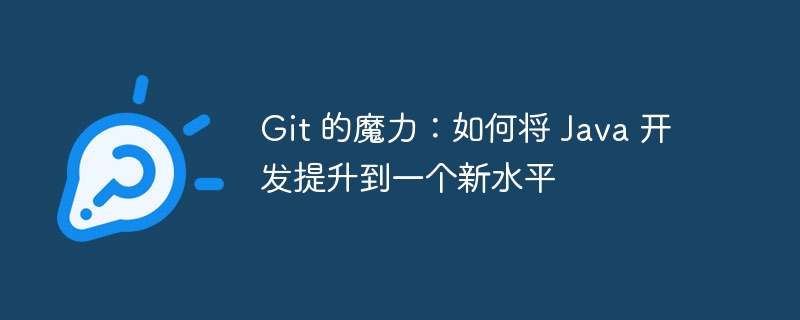Home >Java >javaTutorial >The magic of Git: How to take Java development to the next level
The magic of Git: How to take Java development to the next level
- 王林forward
- 2024-03-27 14:31:54672browse

php editor Apple takes you to explore the magical power of Git in Java development. As a powerful version control tool, Git can not only improve the efficiency of team collaboration, but also accelerate the development cycle and improve Code quality. This article will share how to combine the features of Git to optimize the Java development process, thereby raising the development level to a new level. Let us uncover the mystery of Git together and explore its infinite possibilities in Java development!
One of the most basic uses of git is version control, which enables developers to track changes to the code base, create branches, and easily roll back to previous versions. This is critical for collaborating on large projects as it allows multiple developers to work on code simultaneously without worrying about conflicts or data loss.
Collaboration: Seamless Teamwork
The distributed nature of Git promotes seamless team collaboration. Developers can clone the repository on their local machine, make changes, and push their changes back to the central repository. This allows team members to easily share and merge code, even if they are physically located in different locations.
Branch Management: Isolation Features and Bug Fixes
Git's branch management feature allows developers to create isolated copies of code changes, which is useful for working on multiple features at the same time or fixing bugs. Developers can make changes on specific branches without affecting the main branch, improving efficiency and code quality.
Historical Tracking: Understand Code Evolution
Git records a complete history of every change in the code base, making it easy for developers to see the evolution of their code, understand the differences between versions, and identify the exact commit that introduced a bug. This is essential for debugging, code review, and understanding the development of your project.
Continuous Integration: Automated Building and Testing
Git integrates with continuous integration tools such as jenkins or Travis CI, allowing developers to set up automated build and test pipelines . These tools automatically build and test the code whenever changes are made to the code base, speeding up development cycles and catching bugs early.
Improving Code Quality: Reviews and Merge Requests
Git's merge request feature provides an audit trail for code reviews and merges. Developers can improve code quality and reduce merge conflicts by asking other team members to review and provide feedback before merging.
Large project management: submodules and merge strategies
For large projects, Git's submodule feature allows developers to incorporate external repositories into their own, while merge strategies can help automate the merge process and reduce the risk of merge conflicts for complex projects.
Advanced features: rebasing and monetization
For advanced users, Git provides advanced features such as rebasing and monetization, allowing developers to rewrite commit history or selectively apply changes, thereby achieving finer control of the code base.
in conclusion
Git is a powerful tool for Java developers to improve workflow efficiency, facilitate collaboration, and deliver better software. Developers can take their Java development to the next level by leveraging its capabilities for version control, collaboration, branch management, history tracking, continuous integration, code quality assurance, and advanced features.
The above is the detailed content of The magic of Git: How to take Java development to the next level. For more information, please follow other related articles on the PHP Chinese website!

